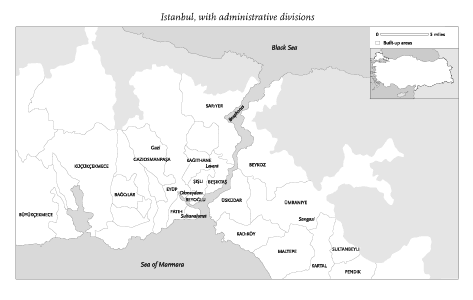Like its predecessors , Istanbul has always been positioned as a ‘world city’, as much by its geo-economic location—at the crossroads between Europe and the Middle East, Russia and the Mediterranean—as by its spectacular setting, straddling the wooded hillsides on both sides of the Bosphorus, with the perfect natural harbour of the Golden Horn slicing its western bank. Its social dynamics in the age of global capital have been scarcely less dramatic. In the last twenty years the city’s population has doubled to over 10 million, reflecting the massive upheavals of the Turkish countryside. Uprooted villagers have poured into the post-imperial city, throwing up whole neighbourhoods of gecekondular—self-built ‘overnight’ dwellings. Istanbul’s transformation in these decades has been aptly described by çaglar Keyder and Ayse öncü as the globalization of a Third World metropolis.footnote1
First- and second-generation squatters, who now make up well over half of Istanbul’s population, have constituted a double problem for the ‘world-city’ image to which its rulers aspired in the neoliberal era. The newcomers have not only mounted militant campaigns against the highways and other infrastructural ‘improvements’ scheduled to be driven through their neighbourhoods. They have also provided a vast vote bank for an Islamism that proclaimed itself totally opposed to the architectural pretensions of global capital—high-rise buildings, ostentatious consumption, luxurious lifestyles—and demanded an environmentally sustainable form of urban development, in harmony with nature. It is these contradictions, worked out against the background of broader economic and ideological upheaval across the region as a whole, that have driven the remaking of the city in recent times.
Istanbul’s modernizing rulers have long struggled to impose their visions of what a world city should be upon its complex urban realities. From 1839, the Ottoman ‘reorganization’ of the Tanzimat era aimed to create a modern capital for the Empire that could compete with Paris or London. At that stage, the main problem for planners was the irregular historical fabric of the city: mosques and palaces, cobbled alleyways, ancient bazaars. Development focused on broadening the streets, constructing transport networks, improving public hygiene and instituting a shift from timber to masonry as building material, in a city plagued by fires.
After the defeat and dismemberment of the Empire, the founders of the Turkish Republic abandoned Istanbul, still occupied by the victors of World War I, to establish the new state’s capital in Ankara. A small, insignificant town—unlike other central Anatolian cities such as Konya, which had a rich Seljuk, Ottoman and Islamic history—Ankara was a blank slate upon which the Atatürk government could construct its own version of urban modernity. It also had an ethnic meaning for the new elite as the heartland of an allegedly ‘pure’ Turkish people—the central ideological bulwark of the Republic—in contrast to the cosmopolitanism of Istanbul with its large Greek population. The development of Ankara absorbed virtually the entirety of infrastructural investment. Although Istanbul retained its role as the country’s main trading centre, its population halved from a pre-war 1.6 million to 806,000 in 1927, and would not regain its 1914 level until 1960 (see Table 1).
During its first two decades the new state imposed draconian restrictions on population movement: cities were for those who were already ‘urban’—in other words, secular and westernized. The small number of rural immigrants who did make their way to Istanbul in the 1920s and 30s generally rented cheap apartments, and had little effect on the make-up of the city. Residential controls were eased in the late 1940s after Turkey’s shift to a parliamentary regime, considered more compatible with the country’s membership of nato than the previous one-party system. Incipient industrialization and the mechanization of agriculture brought a new generation of incomers from the countryside. Unable to afford the rents in the factory districts, they settled in low-control agricultural zones on the outskirts: north and west of the historic centre on the European side of the city, and east and northeast of Kadiköy and Üsküdar on the Anatolian side.
The authorities’ first reaction was to demolish these unofficial settlements; but the easily bought votes of the squatter population, their cheap labour and willingness to take on any kind of work, soon convinced policy makers that the settlers should be incorporated, rather than combated; a strategy that was institutionalized under the centre-right governments of the 1950s. By the 1960s, scattered settlements had grown into substantial squatter neighbourhoods. State policies of import-substitute industrialization intensified the ‘pull factor’ of Istanbul, which now temporarily outweighed the ‘push factor’ of rural unemployment, and drew in provincial town-dwellers as well as the ex-peasants who had constituted the bulk of new arrivals. Squatters offered a growing market for the cheap goods produced by expanding domestic industries, as well as a source of labour. Land and rents in the new neighbourhoods became increasingly commercialized.
During the 1960s and 70s sizeable neighbourhoods in Anatolian Kartal, Pendik and Ümraniye, and European Gaziosmanpasa, Sariyer and Kagithane became left-wing strongholds, sometimes in coalition with the Kemalists. In the 70s, student militants worked to help poorer immigrants build houses, spreading revolutionary ideas and recruiting impressive numbers to their organizations. ‘Liberated zones’ were proclaimed in the squatter districts, attracting armed attacks by the far-right Grey Wolves, allies of the nationalist mhp, which was also trying to create bases there. The Turkish left remained plagued by internal strife and sectarian recrimination, however. By the time of the military coup in 1980, a dozen different groups were competing for the squatters’ allegiance. The dictatorship of 1980–83 crushed them with relative ease.
